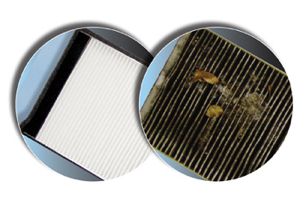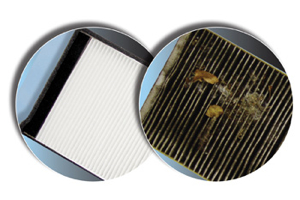Many motorists are unaware their vehicle has a cabin air filter, much less where the filter is or how to replace it.
Cabin air filters have been included in many vehicles since the mid-1980s, and are used in more than 90 percent of newer cars and trucks. Yet many motorists are unaware their vehicle has a cabin air filter, much less where the filter is or how to replace it.
 One of the reasons for this lack of knowledge is that cabin air filters are hidden behind the glove box or under the base of the windshield. They are out of sight — and usually hard to find unless you know exactly where to look. Some hybrid vehicles even have a separate cabin air filter for the hybrid battery cooling system in the back of the passenger compartment.
One of the reasons for this lack of knowledge is that cabin air filters are hidden behind the glove box or under the base of the windshield. They are out of sight — and usually hard to find unless you know exactly where to look. Some hybrid vehicles even have a separate cabin air filter for the hybrid battery cooling system in the back of the passenger compartment.
The filter’s location, replacement procedure and recommended service interval can usually be found in most vehicle owner’s manuals. But many motorists never open the pages of their owner’s manuals so they remain unaware of these filters.
The cabin air filter’s job is to keep dust, pollen and even many pollutants out of the passenger compartment. There are two types: dust and dust and odor. The dust type cabin air filters can trap particles as small as 0.3 microns, which include things like pollen, bacteria, mold spores, even exhaust soot and smoke. Most dust filters will stop 100 percent of all particles that are 3 microns or larger in size, and 95 to 99 percent of particles 1 to 3 microns in size. The combination dust and odor filters have a layer of activated charcoal or baking soda to absorb odors and air pollutants. Some of these filters may even be lightly scented to enhance the driving experience.
The recommended replacement interval is typically every 15,000 to 30,000 miles for dust-type filters, or once a year for combination dust and odor cabin air filters.
What happens if the filter is neglected? With dust/odor filters, the ability to absorb odors quickly diminishes after a year of service. With dust-only filters, the filter media will eventually become clogged causing a restriction in airflow that may adversely affect the operation of the heater, defrosters and air conditioner. Worse yet, a dirty cabin air filter may become a breeding ground for mold or bacteria in a dark, moist environment. This may create an unhealthy situation for the vehicle’s occupants as well as an odor problem.
The service life of a cabin air filter will vary depending on operating conditions. Driving on dusty, rural gravel roads will obviously clog a filter much faster than driving in a relatively clean suburban environment.
Counter displays can help educate customers about cabin air filters as can signage that promotes filter replacement. You should always recommend a cabin air filter as a related sales item when a customer is buying other maintenance items such as motor oil, an engine air filter, spark plugs or even an interior air freshener. Ask them when they last changed their cabin air filter. Chances are they may have never replaced it. You can then look up the application to see if it has a cabin air filter, and which filter fits their vehicle.
Price can sometimes be a stumbling block to making the sale. Many of these filters are more expensive than an engine air filter, and dust and odor filters cost even more. Even so, if you can convince your customer of the importance of changing this filter, you should be able to make the sale.
On most vehicles, a cabin air filter can be replaced in 10 minutes or less. Some disassembly may be required to change the filter, such as removing the glovebox liner or an access panel in the cowl area at the base of the windshield. On a few cars, the filter folds or comes out in two pieces.














